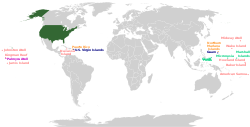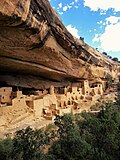United States
This article may contain an excessive number of citations. (October 2019) (Learn how and when to remove this template message)
|
United States of America
| |
|---|---|
Motto:
| |
Anthem:
March:
| |
 | |

The United States, including its territories
| |
| Capital | |
| Largest city | |
| Official languages | None at federal level[b] |
| National language | English[c] |
| Ethnic groups
(2018)[6]
|
By race:
Ethnicity:
|
| Religion
(2017)[7]
|
|
| Demonym(s) | American |
| Government | Federal presidentialconstitutional republic |
| Donald Trump (R) | |
| Mike Pence (R) | |
| Nancy Pelosi (D) | |
| John Roberts | |
| Legislature | Congress |
| Senate | |
| House of Representatives | |
| Independence
from Great Britain
| |
| July 4, 1776 | |
| March 1, 1781 | |
| September 3, 1783 | |
| June 21, 1788 | |
| Area | |
• Total area
| 3,796,742 sq mi (9,833,520 km2)[d][8](3rd/4th) |
• Water (%)
| 6.97 |
• Total land area
| 3,531,905 sq mi (9,147,590 km2) |
| Population | |
• 2018 estimate
| |
• 2010 census
| 308,745,538[e][10] (3rd) |
• Density
| 87/sq mi (33.6/km2) (146th) |
| GDP (PPP) | 2018 estimate |
• Total
| $20.580 trillion[11] (2nd) |
• Per capita
| $62,869[11] (11th) |
| GDP (nominal) | 2018 estimate |
• Total
| $20.580 trillion[11] (1st) |
• Per capita
| $62,869[11] (7th) |
| Gini (2016) | medium · 56th |
| HDI (2017) | very high · 13th |
| Currency | United States dollar ($) (USD) |
| Time zone | UTC−4 to −12, +10, +11 |
• Summer (DST)
| UTC−4 to −10[f] |
| Date format |
|
| Mains electricity | 120 V–60 Hz |
| Driving side | right[g] |
| Calling code | +1 |
| ISO 3166 code | US |
| Internet TLD | |
The United States of America (USA), commonly known as the United States (U.S. or US) or America, is a country comprising 50 states, a federal district, five major self-governing territories, and various possessions.[i] At 3.8 million square miles (9.8 million km2), the United States is the world's third or fourth largest country by total area[d] and is slightly smaller than the entire continent of Europe. With a population of over 327 million people, the U.S. is the third most populous country. The capital is Washington, D.C., and the most populous city is New York City. Most of the country is located contiguously in North America between Canada and Mexico.
Paleo-Indians migrated from Siberia to the North American mainland at least 12,000 years ago.[20] European colonization began in the 16th century. The United States emerged from the thirteen British colonies established along the East Coast. Numerous disputes between Great Britain and the colonies led to the American Revolutionary War lasting between 1775 and 1783, leading to independence.[21] The United States embarked on a vigorous expansion across North America throughout the 19th century, acquiring new territories,[22] displacing Native Americans, and gradually admitting new states until spanning the continent by 1848.[22] During the second half of the 19th century, the American Civil War led to the abolition of slavery in the United States.[23][24] The Spanish–American War and World War I confirmed the country's status as a global military power.
The United States emerged from World War II as a global superpower, the first country to develop nuclear weapons, the only country to use them in warfare, and a permanent member of the United Nations Security Council. During the Cold War, the United States and the Soviet Union competed in the Space Race, culminating with the 1969 U.S. Moon landing. The end of the Cold War and collapse of the Soviet Union in 1991 left the United States as the world's sole superpower.[25]
The United States is a federal republic and a representative democracy. It is a founding member of the United Nations, World Bank, International Monetary Fund, Organization of American States (OAS), NATO, and other international organizations. It is a highly developed country, with the world's largest economy by nominal GDP and second-largest economy by PPP, accounting for approximately a quarter of global GDP.[26] The United States is the world's largest importer and the second-largest exporter of goods, by value.[27][28] Its population is 4% of the world total,[29] but the U.S. holds 31% of the total wealth in the world, the largest share of global wealth concentrated in a single country.[30]
Despite income and wealth disparities, the United States continues to rank very high in measures of socioeconomic performance, including average wage, median income, median wealth, human development, per capita GDP, and worker productivity.[31][32] It is the foremost military power in the world, making up a third of global military spending,[33] and is a leading political, cultural, and scientificforce internationally.[34]
Contents
- 1Etymology
- 2History
- 2.1Indigenous peoples and pre-Columbian history
- 2.2Effects on and interaction with native populations
- 2.3European settlements
- 2.4Independence and expansion (1776–1865)
- 2.5Civil War and Reconstruction era
- 2.6Further immigration, expansion, and industrialization
- 2.7World War I, Great Depression, and World War II
- 2.8Cold War and civil rights era
- 2.9Contemporary history
- 3Geography, climate, and environment
- 4Demographics
- 5Government and politics
- 6Law enforcement and crime
- 7Economy
- 8Infrastructure
- 9Culture
- 10See also
- 11Notes
- 12References
- 13Further reading
- 14External links
Etymology
In 1507, the German cartographer Martin Waldseemüller produced a world map on which he named the lands of the Western Hemisphere America in honor of the Italian explorer and cartographer Amerigo Vespucci (Latin: Americus Vespucius).[36] The first documentary evidence of the phrase "United States of America" is from a letter dated January 2, 1776, written by Stephen Moylan, Esq., to George Washington's aide-de-camp and Muster-Master General of the Continental Army, Lt. Col. Joseph Reed. Moylan expressed his wish to go "with full and ample powers from the United States of America to Spain" to seek assistance in the revolutionary war effort.[37][38][39] The first known publication of the phrase "United States of America" was in an anonymous essay in The Virginia Gazette newspaper in Williamsburg, Virginia, on April 6, 1776.[40]
The second draft of the Articles of Confederation, prepared by John Dickinson and completed by June 17, 1776, at the latest, declared "The name of this Confederation shall be the 'United States of America'".[41]The final version of the Articles sent to the states for ratification in late 1777 contains the sentence "The Stile of this Confederacy shall be 'The United States of America'".[42] In June 1776, Thomas Jefferson wrote the phrase "UNITED STATES OF AMERICA" in all capitalized letters in the headline of his "original Rough draught" of the Declaration of Independence.[41] This draft of the document did not surface until June 21, 1776, and it is unclear whether it was written before or after Dickinson used the term in his June 17 draft of the Articles of Confederation.[41]
The short form "United States" is also standard. Other common forms are the "U.S.", the "USA", and "America". Colloquial names are the "U.S. of A." and, internationally, the "States". "Columbia", a name popular in poetry and songs of the late 18th century, derives its origin from Christopher Columbus; it appears in the name "District of Columbia." Many landmarks and institutions in the Western Hemisphere bear his name, including the country of Colombia.[43]
The phrase "United States" was originally plural, a description of a collection of independent states—e.g., "the United States are"—including in the Thirteenth Amendment to the United States Constitution, ratified in 1865.[44] The singular form—e.g., "the United States is"—became popular after the end of the American Civil War. The singular form is now standard; the plural form is retained in the idiom "these United States". The difference is more significant than usage; it is a difference between a collection of states and a unit.[45]
A citizen of the United States is an "American". "United States", "American" and "U.S." refer to the country adjectivally ("American values", "U.S. forces"). In English, the word "American" rarely refers to topics or subjects not directly connected with the United States.[46]
History
Indigenous peoples and pre-Columbian history
It has been generally accepted that the first inhabitants of North America migrated from Siberia by way of the Bering land bridge and arrived at least 12,000 years ago; however, increasing evidence suggests an even earlier arrival.[20][47][48]After crossing the land bridge, the first Americans moved southward along the Pacific coast[49] and through an interior ice-free corridor between the Cordilleran and Laurentide ice sheets.[50] The Clovis culture appeared around 11,000 BC, and is considered to be an ancestor of most of the later indigenous cultures of the Americas.[51] The Clovis culture was believed to represent the first human settlement of the Americas.[52] Over the years, more and more evidence has advanced the idea of "pre-Clovis" cultures including tools dating back about 15,550 years ago. It is likely these represent the first of three major waves of migrations into North America.[53]
Over time, indigenous cultures in North America grew increasingly complex, and some, such as the pre-ColumbianMississippian culture in the southeast, developed advanced agriculture, grand architecture, and state-level societies.[54]The Mississippian culture flourished in the south from 800 to 1600 AD, extending from the Mexican border down through Florida.[55] Its city state Cahokia is considered the largest, most complex pre-Columbian archaeological site in the modern-day United States.[56] In the Four Corners region, Ancestral Puebloans culture developed as the culmination of centuries of agricultural experimentation, which produced greater dependence on farming.[57] Three UNESCO World Heritage Sites in the United States are credited to the Pueblos: Mesa Verde National Park, Chaco Culture National Historical Park, and Taos Pueblo.[58][59] The earthworks constructed by Native Americans of the Poverty Point culture in northeastern Louisiana have also been designated a UNESCO World Heritage site. In the southern Great Lakes region, the Iroquois Confederacy (Haudenosaunee) was established at some point between the twelfth and fifteenth centuries.[60]
The date of the first settlements of the Hawaiian Islands is a topic of continuing debate.[61] Archaeological evidence seems to indicate a settlement as early as 124 AD.[62]







